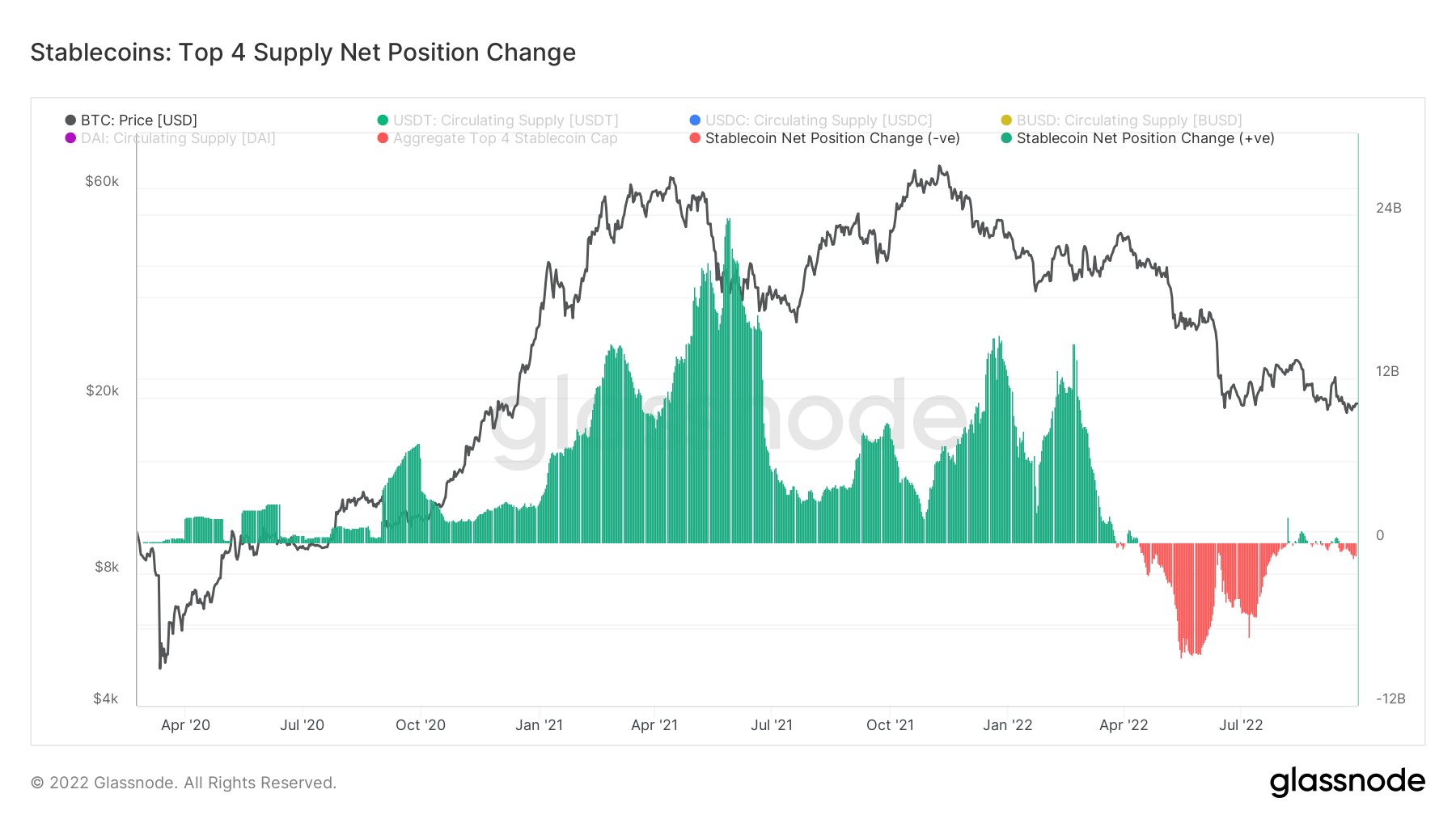1. Solana Wallet
Connect a Solana self-custody wallet (Phantom, Solflare or Torus).
A weekly recap of key Bitcoin metrics and the macro factors affecting its price performance in the market, published every weekend.

Cover art/illustration via CryptoSlate
The era of financial repression after the GFC that has seen rapidly inflated asset values and rate expectations of 0 has unraveled since the pandemic ended. Since the Second World War, the most significant fiscal stimulus package has contributed to supply chain failures and surges in goods and services. This has unleashed a wave of demand for services with labor that remains in short supply. Fixed income yields have surged to multi-year highs, and investors continue to flock to the dollar.
The old era has ended; central banks have kept interest rates at all-time lows for the past two decades and have been extremely slow to hike. However, since 1999, the combined moves from the FOMC, ECB, and BOE have had a combined rate change of 2% for September and 3.75% over the quarter. The most since the establishment of the ECB.

Credit default swaps (CDS) may seem complicated and heard during the GFC back in 2008, but the CDS market is telling us something similar may be occurring in 2022.
History doesn’t repeat, but it often rhymes.
What are CDS? In layman’s terms, a swap is a contract between two parties agreeing to swap one risk for another. One party purchases protection from another party against losses from a borrower’s default.
With every swap, there is a ‘counterparty risk.’ During the housing crisis in 2008, Lehman Brothers went bankrupt and could not pay back the insurance they sold to investors. The owners of the CDS suffered a loss on the bonds that defaulted.
CDS is a good indicator of potential defaults; when the price of the CDS rises, the insurance becomes more expensive (higher elevated chance of default).
In recent times it hasn’t been so good for Credit Suisse (CS), a record trading loss, shuttered investment funds, multiple lawsuits, corporate scandal, and a new CEO. Poor performances have seen more than 10% of its 45,000 workforce fired while leaving the US market and splitting up its investment bank.
Default insurance on Credit Suisse is approaching the same level as during Lehman Brothers’ collapse.
As a result of the above, the share price has tanked from $14.90 in February 2021 to $3.90 currently and is avoiding going to the market for funding due to its tumbling share price. CS has dropped below a quarter of its book value while its market cap is below its revenue.
Should you be concerned about your CS pension? Holding USD doesn’t mean a lot because all you have is an IOU from the bank if they go insolvent.
Many Bitcoiners believe BTC is the best protection against fiat failure due to the lack of counterparty risk. As long as you custody and store Bitcoin correctly, the Bitcoin is yours, and there is no default risk on the insurance you own. Unlike CDS, Bitcoin has no expiry option. In addition, it is also protected against hyperinflation due to its finite supply.
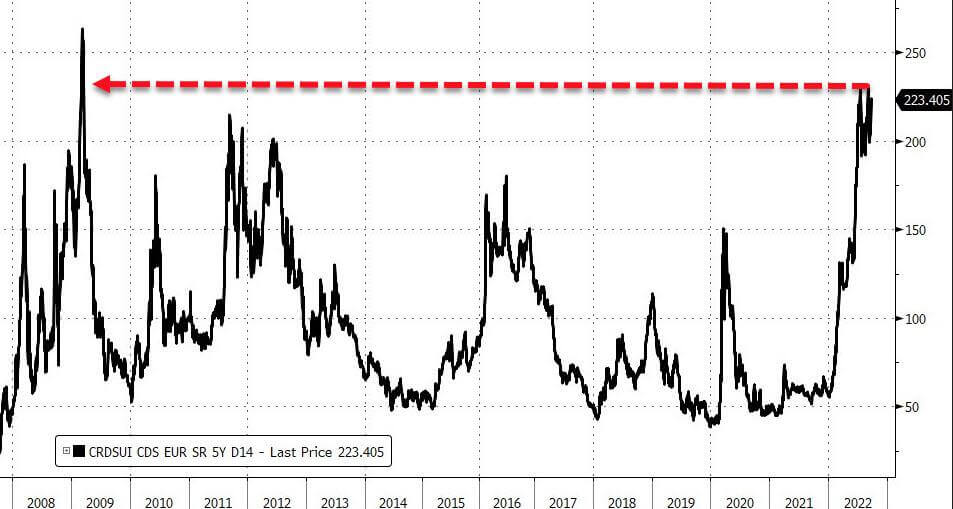
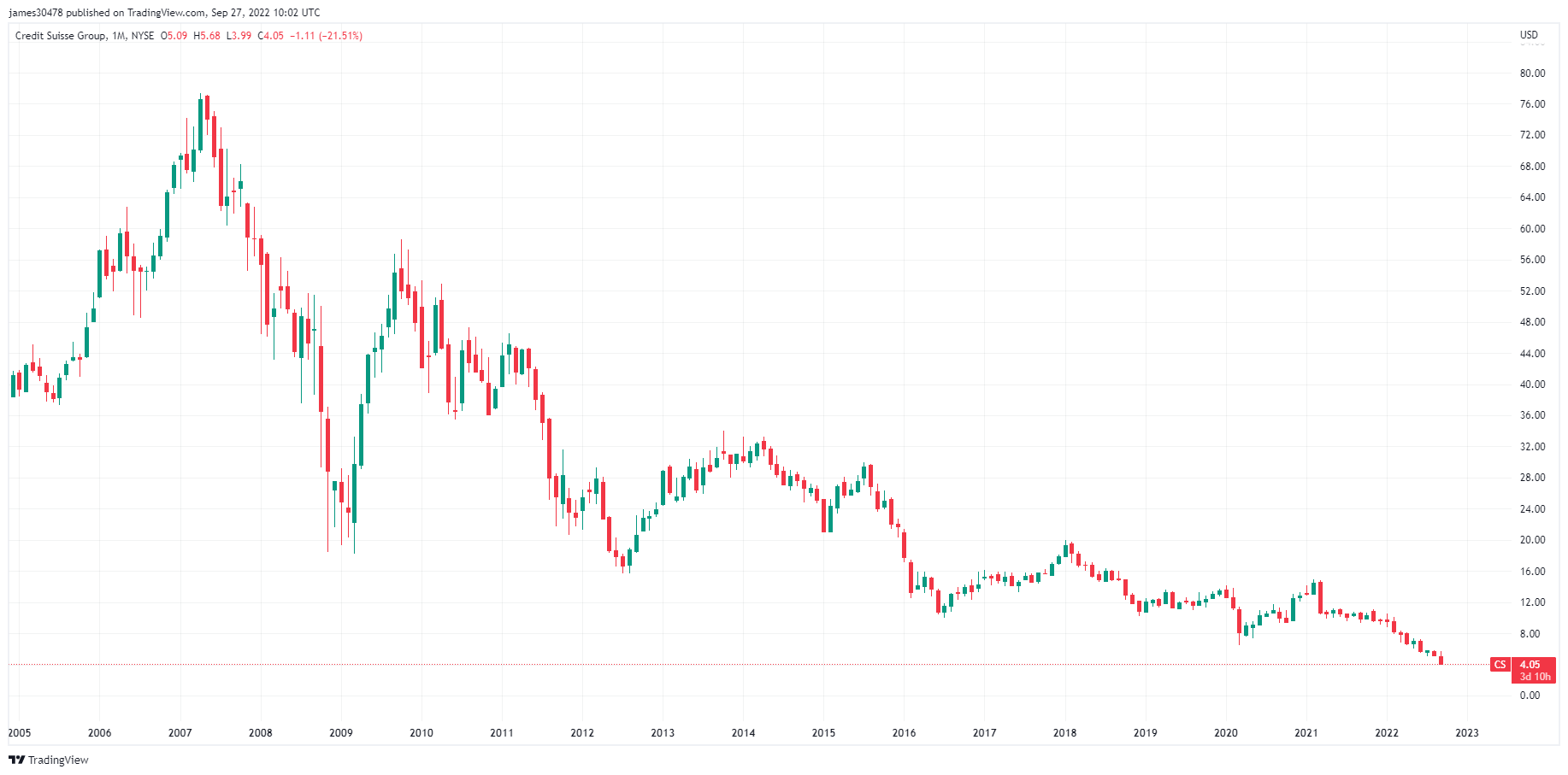
The DXY has been devastating in 2022; it is up almost 20%, leaving all major currencies in trouble. Canadian and Australian dollars are down 8% and 11%, respectively, the Euro down 18%, while the British Pound and the Japanese Yen are down over 20% each.
However, one currency has emerged victorious over the US dollar, the Russian Ruble, which is almost up a whopping 30% on the DXY.

As the DXY strengthens, this puts pressure on emerging market currencies with US dollar-denominated liabilities. While their currency weakens comparatively against the US dollar, it makes it harder to meet the obligations of their payments in USD.
This ultimately leads to these markets printing more of their currency, most likely leading to hyperinflation (every fiat currency that has ever existed has failed with an average life expectancy of 27 years) or adoption of a US dollar standard, which we can see in El Salvador is trying to move away from by adopting Bitcoin.
CEO Santiago Capital Brent Johnson explains the failure of fiat currencies with a theory called the dollar milkshake theory; the loss of fiat currencies will be due to an ever-increasing demand for US dollars, encompassed with a short supply of dollars, when the Fed stops making new dollars, demand for existing dollars goes up.
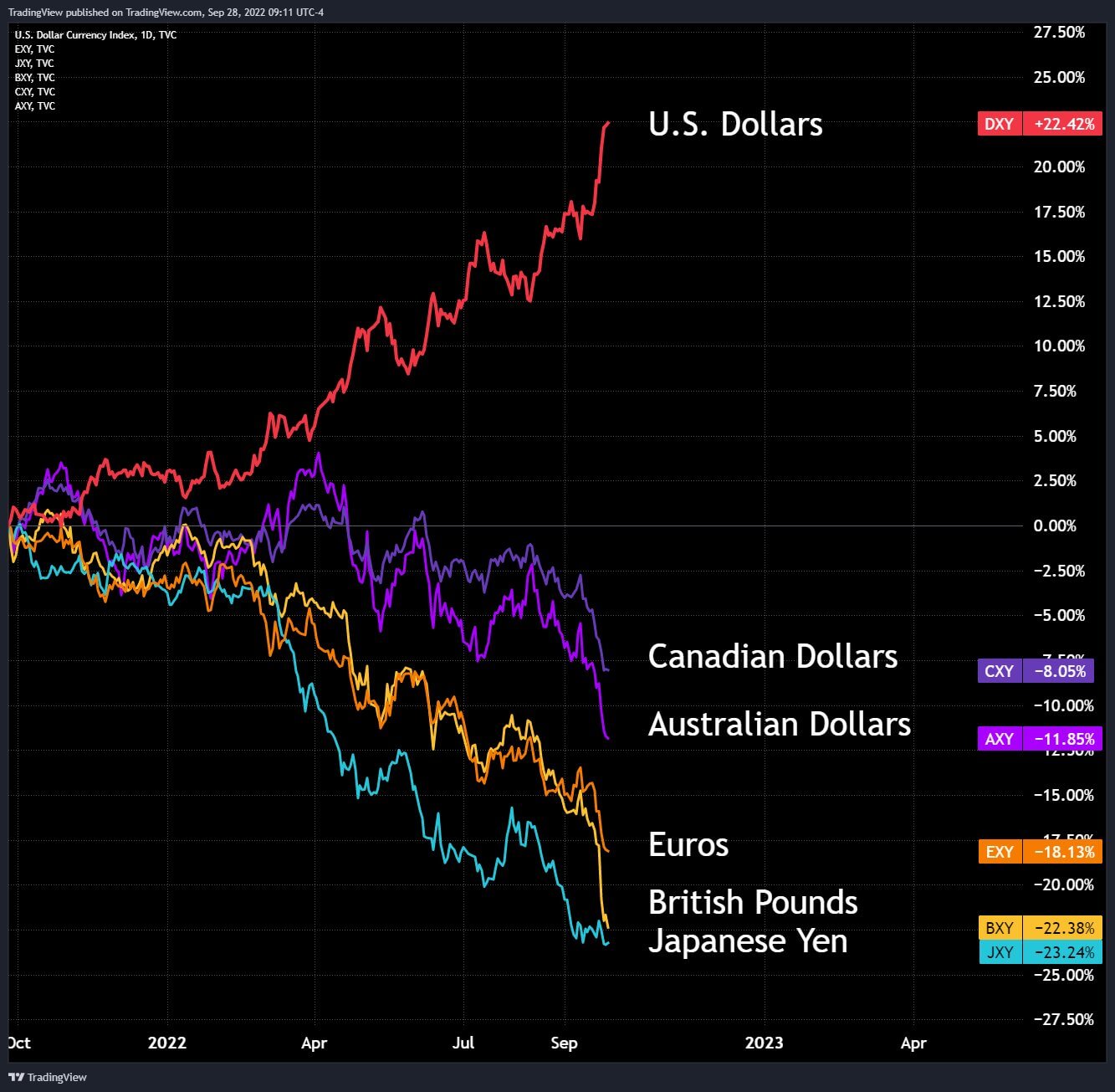
On Sept. 27, The Move index (the “VIX of the bond market”) closed at 158.12. This is the second-highest print in 13 years. Since the GFC, the only higher score was the height of the pandemic on March 9, 2020.

When the Move index exceeds 155, the Fed discusses the possibility of cutting interest rates to 0 or starting their quantitative easing program. However, this is not the case, the fed is in the midst of its quantitative tightening program, and the market is still pricing 4.25 – 4.5% interest rates for the end of 2022.
Last week’s report discussed the the 60/40 portfolio, which had been at its worst performance since 1937. Below are the top 20 peak-to-trough drawdowns for the S&P 500 going back to 1961. Never, in history, when witnessing an extreme drawdown of stocks, have US treasuries (the risk off asset) plunged more than stocks. If alarm bells aren’t ringing, they should now.
To reinforce the point above, almost $60 trillion has been wiped out in US stocks and the fixed income market.
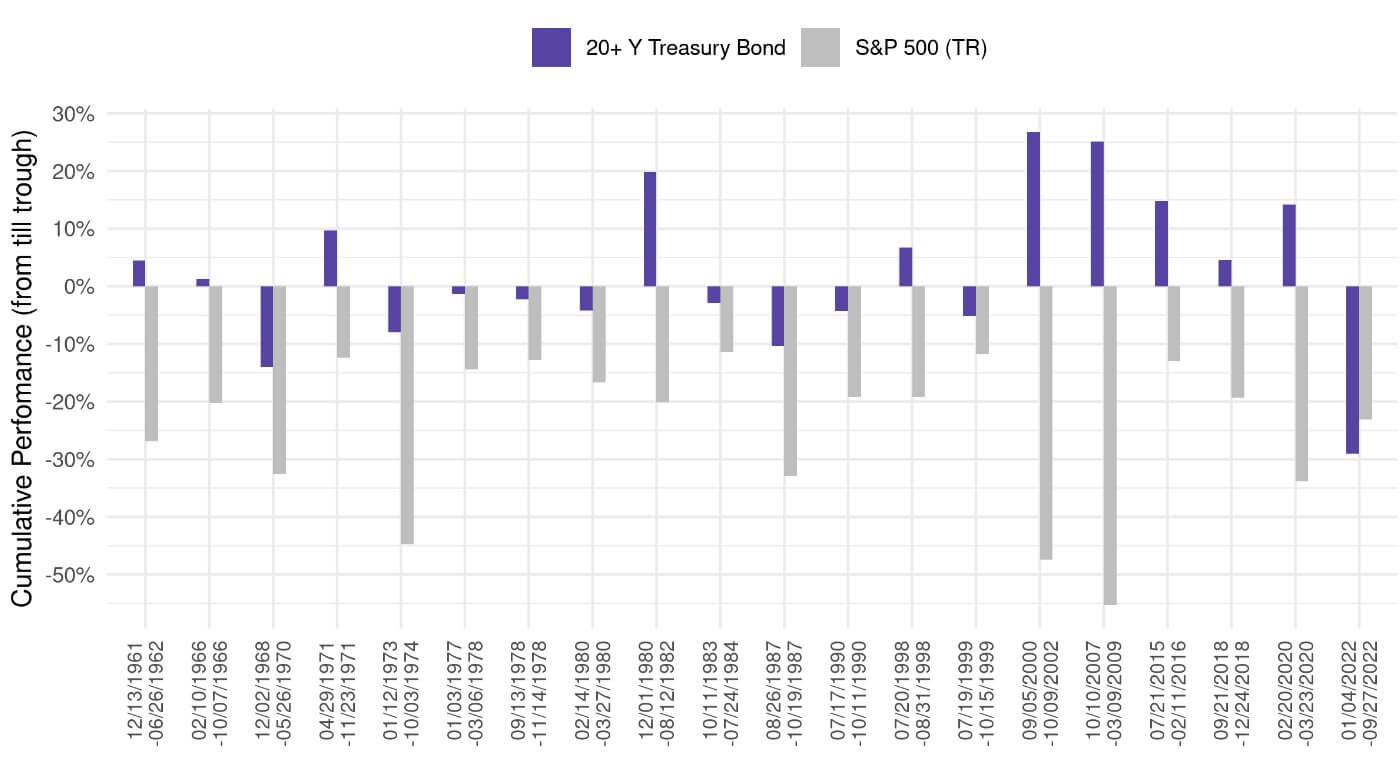

On Sept. 26, the British pound collapsed against the US dollar to 1.03, sinking to an all-time low. This was on the back of the chancellor unveiling a fresh fiscal stimulus that will increase the UK’s estimated deficit by £72 billion, adding fuel to the inflation fire. The poor performance of the sterling was also coupled with a mere 50 bps hike by the BOE. Since then, the sterling has continued its collapse along with gilts and FTSE 100.
As the days continued, rumblings were heard of emergency rate hikes from the BOE to contain sky-high inflation. However, on Sept 28, the BOE carried out the temporary purchases of long-dated UK bonds doing the inverse of controlling inflation. This was a pivot from the BOE; for yields to be contained, quantitative easing had to continue, which would only devalue the pound further. The BOE is trapped, and all other major central banks may likely follow suit.
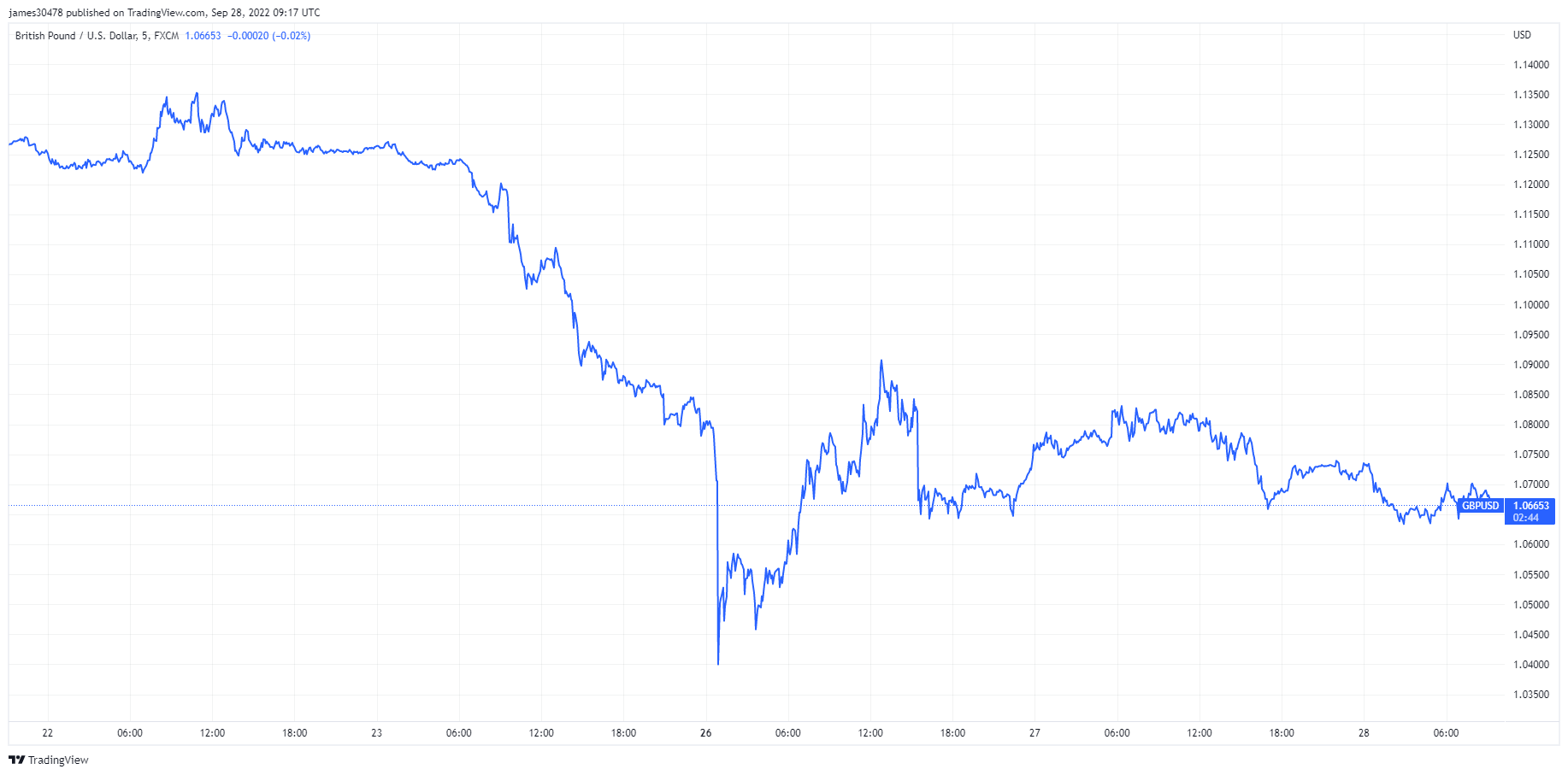
With the pound plummeting to its 30-year low, people flocked to hard assets to avoid major losses. On Sept. 26, the BTC/GBP trading volume soared over 1,200% as British pound holders began aggressively purchasing Bitcoin. This stands in sharp contrast to the BTC/USD pair, which has seen a relatively flat trading volume on centralized exchanges throughout the summer.
British chancellor Kwasi Kwarteng’s newly imposed tax cuts and borrowing plans further debased the pound and led to a sharp decrease in U.K. government bonds. To protect their holdings from risks associated with inflation and rising interest rates, most pension funds invest heavily in long-term government bonds. The Bank of England’s emergency measures are an attempt to provide support to thousands of cash-strapped pension funds that are in danger of failing to meet margin calls.
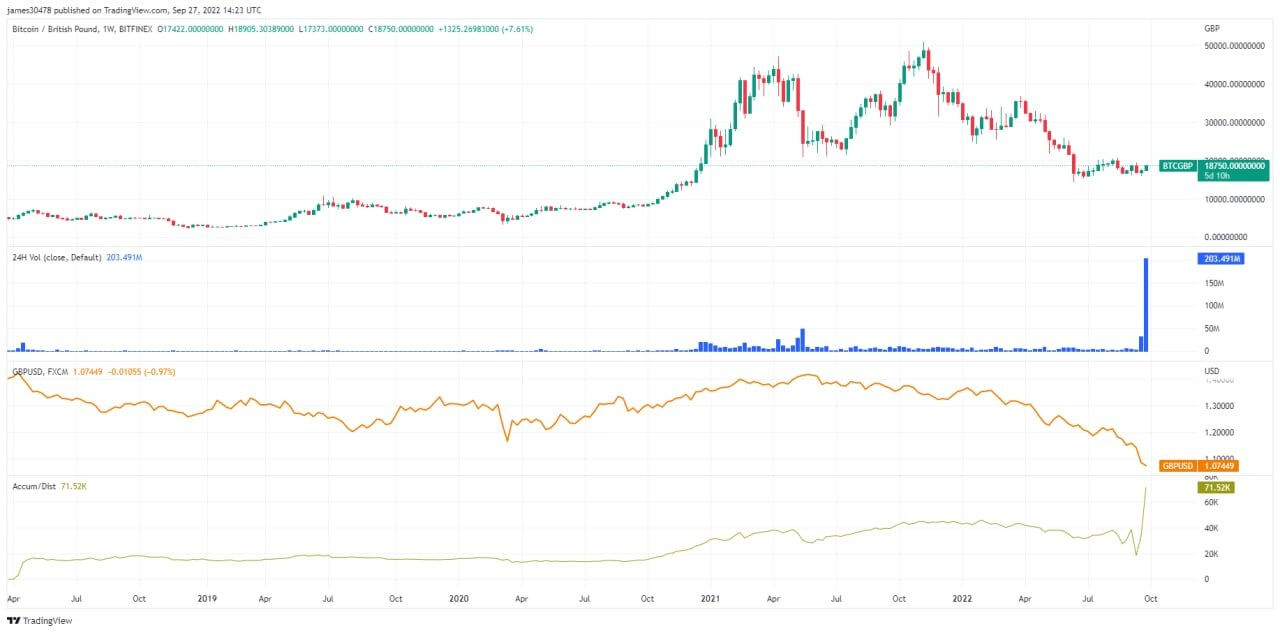

The number of unique entities that appeared for the first time in a transaction of the native coin in the network. Entities are defined as a cluster of addresses that are controlled by the same network entity.
New entities have sunk to multi-year lows and re-tested a low seen during 2020, which tells us there isn’t a new influx of participants coming into the ecosystem. However, we were still higher than the previous bear market cycle in 2018. From the data, new tourists are coming in and staying; the network continues to put in a higher high each cycle.

The Futures Open Interest Leverage Ratio is calculated by dividing the market open contract value by the market cap of the asset (presented as %). This returns an estimate of the degree of leverage relative to market size to gauge whether derivatives markets are a source of deleveraging risk.
Futures’ open interest leverage ratio is approaching all-time highs; this increases the chance of further deleveraging and liquidations events. During the Luna collapse and multiple insolvencies that took place from April – July 2022, a lot of leverage has been wiped out, but it still seems a lot of risk appetite exists.
Traditional finance is starting to see much of its leverage unwind; it will be crucial for Bitcoin to hold this price range as the value continues to be wiped out in stocks and fixed-income.
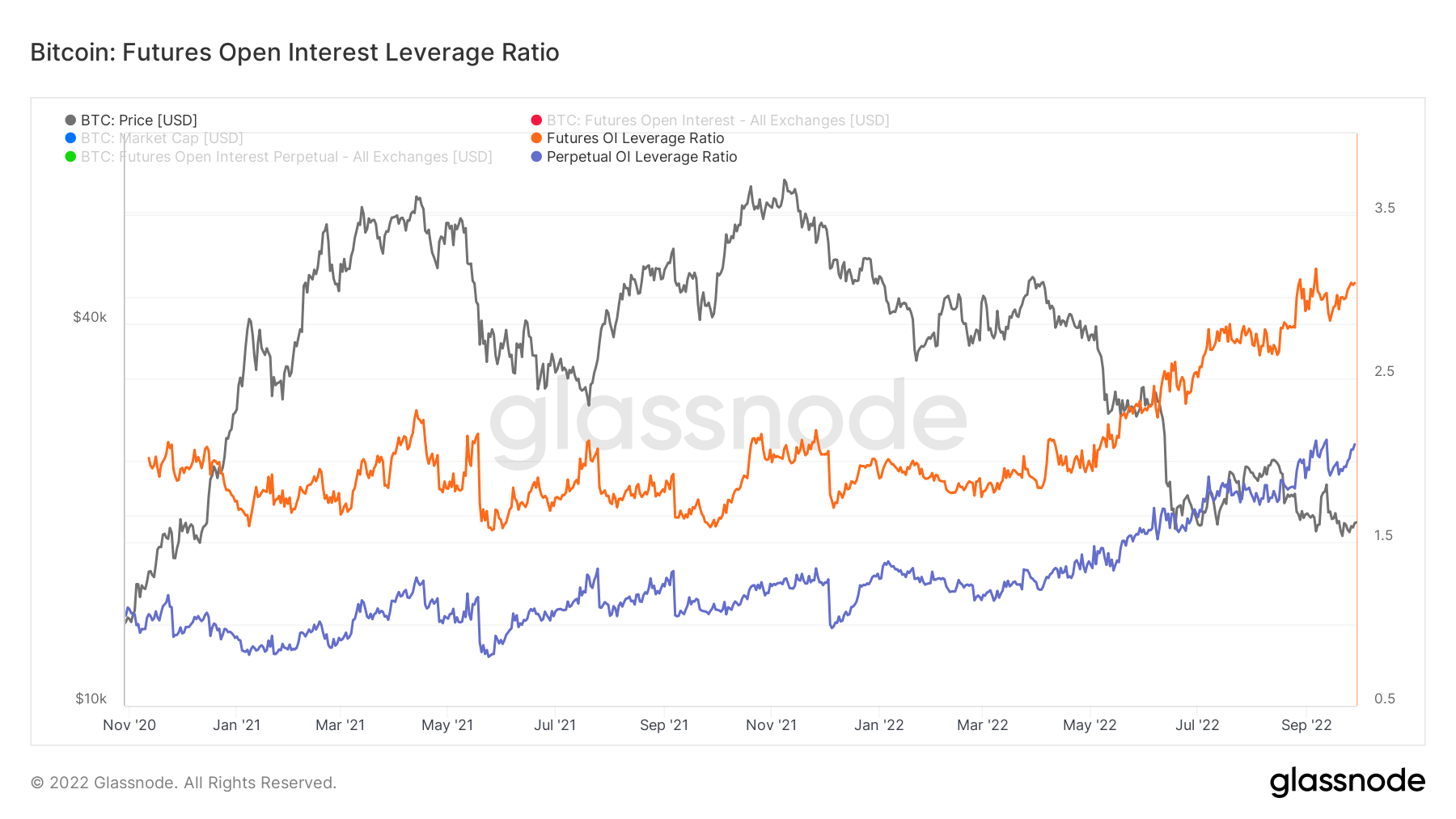
The total open interest of call and put options by strike price for a specific options contract. A call option gives the holder the right to buy a stock, and a put option gives the holder the right to sell a stock.
Zooming into December 30, thousands of calls for over $35,000 a Bitcoin are encouraging. September has been a bloodbath for traditional finance yet Bitcoin is only down 2.5% and has held $18,000 firmly. However, with earnings season on the horizon and bitter winter for Europe, it may be hard to see these numbers end the year.

The Mining Pulse shows the deviation between the 14-day average Block Interval and the target time of 10 minutes. Values of the oscillator can be considered as how many seconds faster (negative) or slower (positive) are blocks being mined relative to the target block-time of 600s.
Currently, the mining pulse is marginally in positive territory, which indicates the Bitcoin network is in a slower block time as the hash rate hit an all-time high recently. Mining difficulty was also at an all-time high. However, we are now seeing declines in both. The Hash rate has started to come down while difficulty has its first downwards adjustment since July.
As difficulty stays near all-time highs, this will continue to pressure miners; expect to see difficulty continue to drop while unprofitable miners continue to get purged from the network. For the second half of 2022, we have been above the mining pulse, which has also coupled with miner capitulation, miners are not out of the woods at the moment, but it looks much healthier than it did in previous weeks and months.

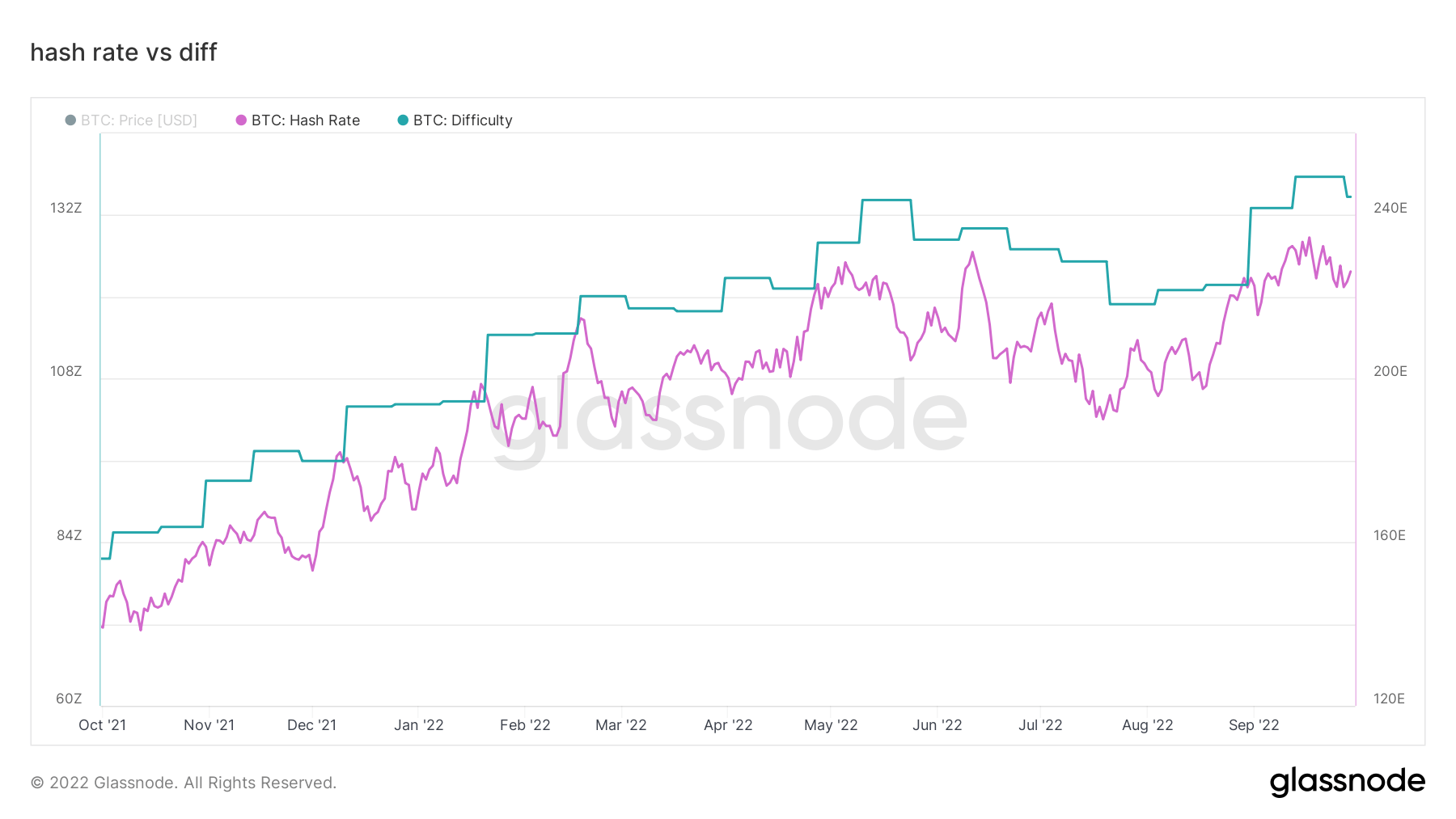
Coin Days Destroyed (CDD) for any given transaction is calculated by taking the number of coins in a transaction and multiplying it by the number of days since those coins were last spent.
90D Coin Days Destroyed is the 90-day rolling sum of Coin Days Destroyed (CDD) and shows the number of coin days destroyed over the past year. This version is age-adjusted, meaning that we normalize by time to account for the increasing baseline as time goes by.
Coin days destroyed visualize the periods when old and younger coins have been spent. The metric is at an all-time low, demonstrating that mature coins are holding on to their Bitcoin and thus being the dominant behavior for this type of investor. During the bull runs of 2013, 2017, and 2021, CDD significantly increased as this type of cohort sold for profits. We are amid bear market accumulation.
The metric spent volume age bands support diamond hands from LTHs, separating the on-chain transfer volume based on the coins’ age. Each band represents the percentage of the spent volume previously moved within the period denoted in the legend.
LTHs (6+ months) are spending coins at an aggressive rate during the peak of the 2021 bull run at the beginning of January at a high of almost 8% of the cohort. However, as time goes on and the price of Bitcoin has continuously dropped into 2022, mature hands are reluctant to sell BTC at this price range as this HODLing behavior has been one of the strongest for many years.

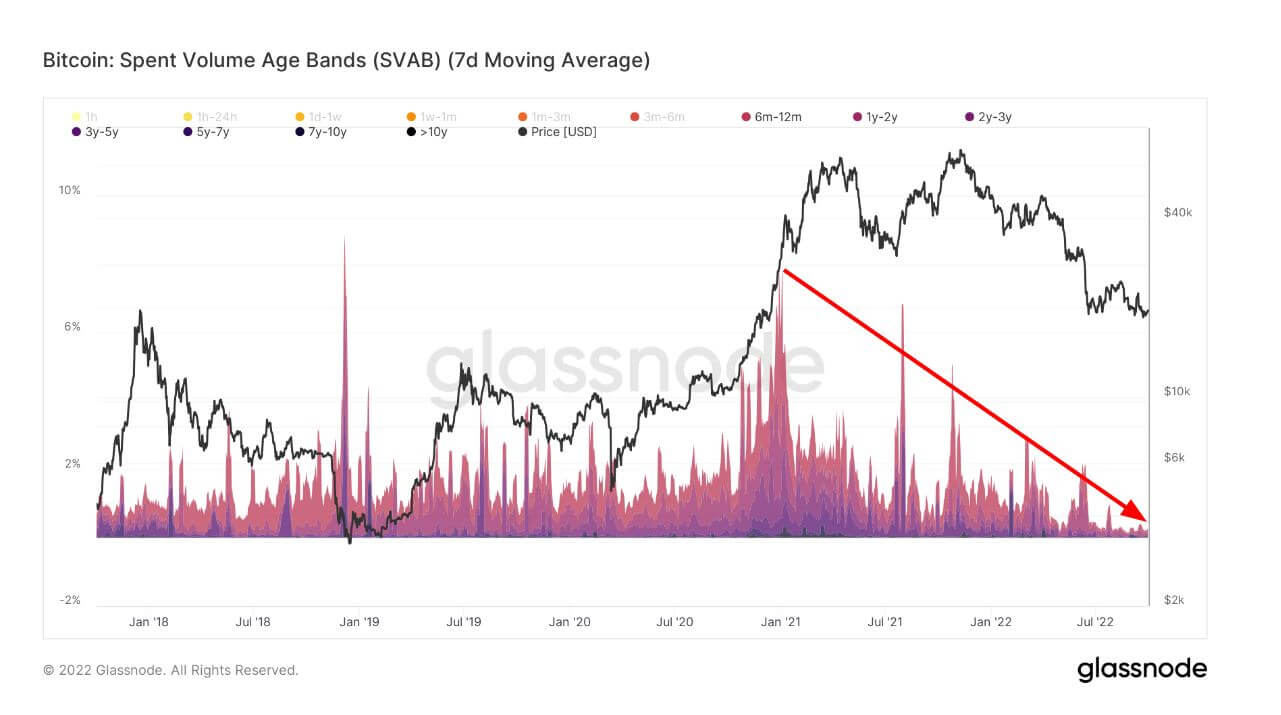
One of the better news stories this cycle is that the lightning network capacity keeps growing, hitting all-time highs each week, which is all pure organic growth. We should expect to cross the 5,000 BTC mark next week.

Long-term holders are defined as holders of Bitcoin for more than 155 days and are considered the smart money of the ecosystem and sell during bull runs but accumulate and hold during bear markets. This is a consistent approach from this cohort, while the inverse occurs with short-term holders as they are more prone to dollar value.
Throughout BTC history, when peak bull runs occur, LTHs sell, but when bear markets come to the fold, they accumulate. This is happening now, which is encouraging, holding over 13.6 million BTC, while STH’s starting to sell and decreasing their position size.
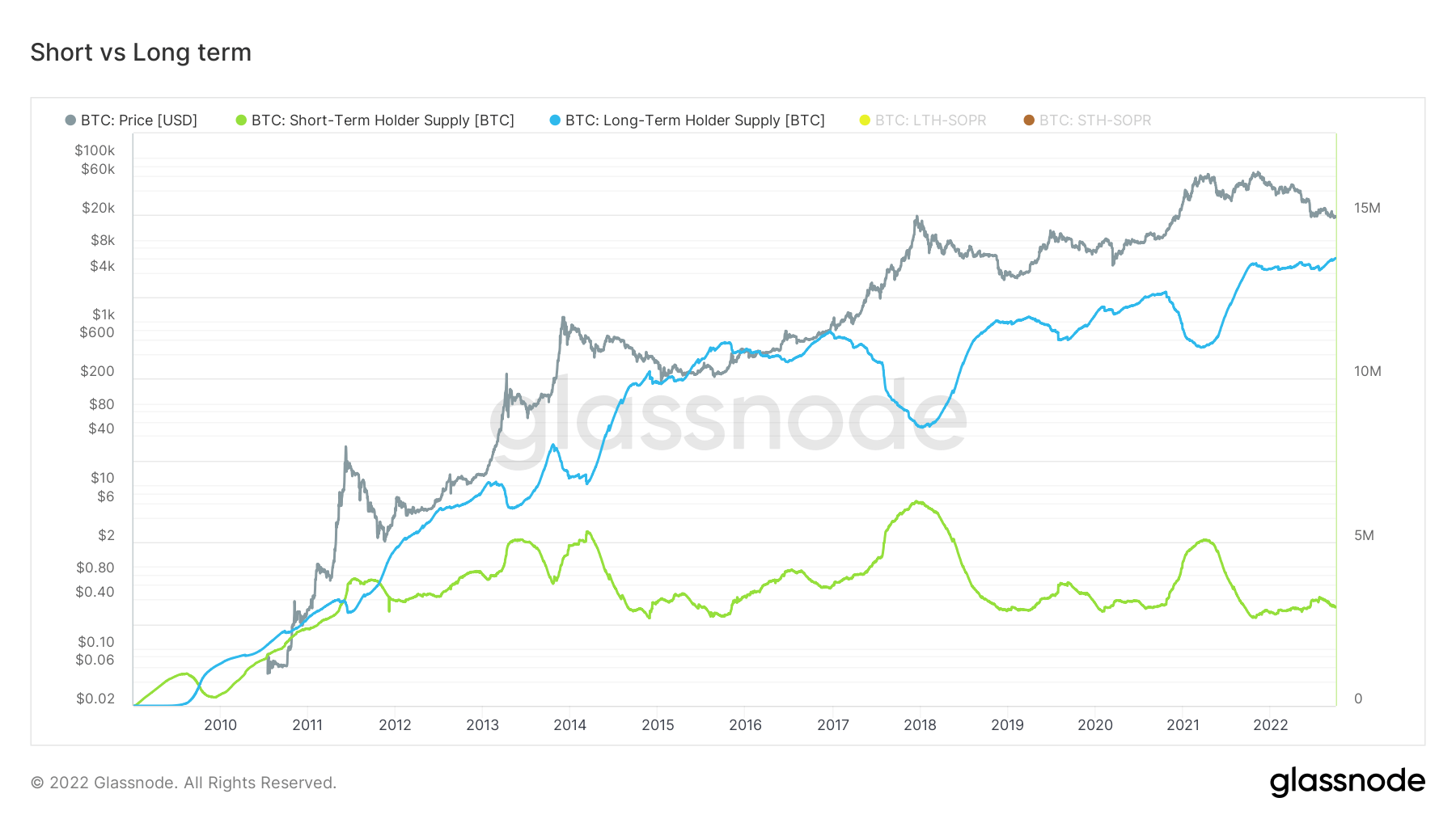
The URPD metric is a tool that shows at which prices the current set of Bitcoin UTXOs were created, i.e., each bar shows the number of existing bitcoins that last moved within that specified price bucket. The following metrics are a series of variants that further break down the data, looking at specific market cohorts.
In this version, the supply is segmented according to the total balance of the owning entity. This makes it possible to distinguish “whales” from “fish.” Exchanges are treated separately (grey). All supply is shown in the price bucket at which the respective entity has (on average) acquired its coins.
The black vertical bar shows the market price at the chart production timestamp.
An ample supply gap occurs below the June low of $17.6k down to the range of $10-$12k. A lot of the supply that has been bought around the $20k are investors with less than 1 Bitcoin; this could spell trouble if Bitcoin were to go lower, and this cohort would experience a further unrealized loss which could trigger a further downside.

This chart shows the 30-day net change in the supply of the top four stablecoins USDT, USDC, BUSD, and DAI. Note that the supplies of these stablecoins are distributed between multiple host blockchains, including Ethereum.
2021 was a momentous year for stablecoins in particular, which saw a massive amount of stablecoins flowing onto exchanges as defi took off. Identifying the top 4 stablecoins, USDT, USDC, DAI, and BUSD, up to $24 billion were flowing at the peak in the middle of 2021.
However, 2022 has been a different story: many withdrawals and uncertainty. This has been coupled with macro uncertainty and the collapse of Luna. Since August, withdrawals have declined dramatically. It is very much muted activity which is positive to see in this market environment.
